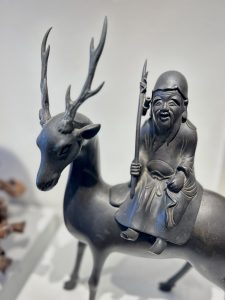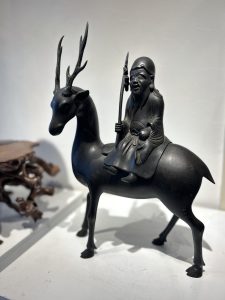春野菜にエネルギーをもらっています(愛知県名古屋市千種区姫池通 骨董品買取 古美術風光舎)
2024.04.24
みなさまこんにちは。スタッフHでございます。
名古屋は本日も雨のため店内は少し薄暗くなっておます。そのためか照明の下のブロンズの香炉がライトを浴びていつもよりつやつやと輝いて見えます。

ジブリ映画にでも登場しそうな凛々しい鹿の上に、何とも優しい笑顔の寿老人が腰かけております。
右足がぴょこんと上がっているのがたまらなく可愛いいと思うのですがいかかでしょう。
この寿老人は取り外せるようになっており、鹿の胴体が空洞になっています。香を焚くと寿老人の右袖口の穴から煙が出る仕掛けとなっています。お香の煙に包まれた姿も一度見てみたいものです。
さて話は全く変わるのですが、この時期買い物に行くと春キャベツ、たけのこ、新玉ねぎなど美味しい春野菜が並んでいます。食べたいという欲求とは裏腹にたけのこなどは調理の手間を想像すると購入するのをためらってしまいます。
そんな中、先日野菜コーナーで「うすい豆(うすいえんどう)」を見つけました。私が見過ごしていただけなのか、豆嫌いな家族がいたからか、これまであまり目に入っていませんでした。子供の頃に大好物だった「豆ごはん」の豆はグリーンピースではなく「うすい豆」だったと知ったのは大人になってからでした。うすい豆は皮が薄く、ホクホクとしたお芋のような食感と繊細な甘さがあり、塩気のあるご飯と相性がいいのです。
心底食べたい物のためなら、さやから豆を出す手間など厭いません。と偉そうに言いますが、そんな大した手間ではありません。豆をボウルに取り出しながら子供の頃の記憶が豆の香りと共によみがえります。炊きあがった豆ごはんは懐かしいお味でした。豆ばかり食べて叱られた記憶も一緒によみがえりました。
うすい豆は実が大きくてグリンピースと比べて青臭さが少ないため春を告げる「豆ごはん」に旬の食材としてよく使われます。明治時代にアメリカから輸入され、大阪府羽曳野市の碓井町(うすいちょう)で栽培されたのが始まりとされ、うすい豆の名前の由来となっています。その後、気候や風土が適しているという理由で和歌山県で栽培が盛んになりました。和歌山で生産され大阪で70%消費されるともいわれているそうです。
春のこの時期、店頭には青々としたスナップエンドウや絹さやなどの豆類もたくさん並びます。実はどちらも「マメ科エンドウ属」の同じ植物で、収穫の時期により呼び名が変わるとのこと。
最も収穫時期が早いのが「豆苗」で、えんどうまめができる前の若い芽を食べます。成長が進むと未熟なうちに収穫したものが「さやえんどう」で名前の通りさやごと食べられます。しばらくすると実が育ち始め、実とさやがほどよく成長し、どちらも一緒に食べられるのがスナップエンドウ。「スナップ」は英語でぽきっと折れるという意味だそうです。さらに成長が進み実が大きくなり、まだ未成熟の実を食べるのがグリーンピースと呼ばれるものです。
エンドウ豆の品種には「うすいえんどう(うすい豆)」、甘さが強い「砂糖さやえんどう」、さやが紫色の「ツタンカーメンのエンドウ豆」などがあります。ツタンカーメンとはまた大胆なネーミングと思っておりましたら、本当にエジプトを統治したツタンカーメン王(紀元前1342年~1324年)の墓で見つかったエンドウ豆の子孫と考えられているようです。金などの豪華な副葬品と一緒にエンドウ豆が発見されたとか。日本には中国を経て遣唐使により9~10世紀頃にもたらされたといわれています。悠久の昔から栄養価の高い貴重な食材として存在していたのですね。それを芽からさやまで様々な食べ方で楽しもうとした人々の食へのこだわりもすごいです。
実は枝豆も大豆が成熟する前に収穫されたものだということを子供に教えてもらった気がします。スーパーに並んでいる品物ばかりを眺めていてはいけませんね。

それでは、また次の機会に。
Hello everyone. This is Staff H.
It is raining in Nagoya today, so the store is a little dimly lit, and the bronze incense burner under the light is shining brightly as if bathed in a spotlight.
A gentle smiling Jurojin sits on top of a dignified deer that looks like it could have appeared in a Ghibli movie.
His right leg is raised in the air, which I think is very cute.
This Jurojin is removable, and the body of the deer is hollow. When incense is burned, smoke comes out of the hole in the right cuff of the Jurojin. It would be interesting to see the figure surrounded by the smoke of incense.
This is a completely different story, but this time of year, when I go shopping, I see delicious spring vegetables such as spring cabbage, bamboo shoots, and fresh onions. Despite my desire to eat them, I hesitate to buy bamboo shoots when I imagine the time and effort required to prepare them.
Then, the other day, I found “Usui-mame” (Usui peas) in the vegetable section. Perhaps it was because I overlooked them, or perhaps it was because I have a family member who does not like beans, but I had never really looked at them before. It wasn’t until I became an adult that I learned that the beans in my favorite childhood dish, “mamegohan (rice with beans),” were not green peas, but rather “light beans. Usui-mame has a thin skin and a delicate sweetness that goes well with salty rice.
I am willing to go to the trouble of taking the beans out of the pod for something I truly want to eat. I say, “I’m willing to go to the trouble of taking the beans out of the pod for something I truly want to eat. As I take out the beans into the bowl, the aroma of the beans brings back memories of my childhood. The cooked rice tasted nostalgic. It also brought back memories of being scolded for eating only beans.
Compared to green peas, light beans are larger and have less of a green smell, so they are used as a seasonal ingredient in “mame gohan,” which heralds the beginning of spring. Usui-mame was first imported from the United States during the Meiji period (1868-1912) and cultivated in Usui-cho, Habikino City, Osaka Prefecture, hence the name “Usui-mame. Later, the cultivation of Usui-mame flourished in Wakayama Prefecture because the climate and climate were suitable for it. It is said that 70% of the beans produced in Wakayama are consumed in Osaka.
During this time of spring, many green snap peas, peas such as pea pods, and peas such as pea pods can be seen in stores. In fact, both are members of the same family, Fabaceae, and are called by different names depending on when they are harvested.
The earliest to be harvested are “mame-mae” (bean sprouts), which are young shoots before endo-peas are formed. When they are harvested while they are still growing and immature, they are called “Saya-endo,” and as the name suggests, the whole pods are eaten. After a while, the fruits begin to grow, and when the fruits and pods have grown to a good size, the snap peas can be eaten together. The word “snap” means “to snap” in English. The peas continue to grow and the pods become larger, and the immature pods are called “green peas”.
There are several varieties of peas, such as the “Usui endo (light pea),” the “Sugar Saya Pea,” which has a strong sweet taste, and the “Tutankhamen’s Pea,” which has a purple pod. Tutankhamen” is another bold name, but it is thought to be a descendant of the peas found in the tomb of King Tutankhamen (1342-1324 B.C.), who really ruled Egypt. The peas were found along with gold and other luxurious burial accessories. It is said that peas were brought to Japan around the 9th to 10th century by Japanese envoys to the Tang Dynasty via China. So peas have existed as a valuable and nutritious foodstuff for a long time. It is also amazing that people were so particular about food that they tried to enjoy it in various ways from the sprout to the pod.
I remember learning from my children that edamame is also harvested before the soybeans mature. We shouldn’t just look at the products in the supermarket.
See you next time.
*******************
ご実家の整理やお片付けなどをされている方のご相談などが多くございます。
お片付けなどくれぐれもご無理のないようになさってくださいませ。
風光舎では古美術品や骨董品の他にも絵画や宝石、趣味のお品など様々なジャンルのものを買受しております。
お片付けをされていて、こういうものでもいいのかしらと迷われているものでも、どうぞお気軽にご相談下さいませ。
また風光舎は、出張買取も強化しております。ご近所はもちろん、愛知県内、岐阜県、三重県その他の県へも出張いたします。
まずは、お電話お待ちしております。
愛知県名古屋市千種区姫池通
骨董 買取【古美術 風光舎 名古屋店】
TEL052(734)8444
10:00-18:00 OPEN

